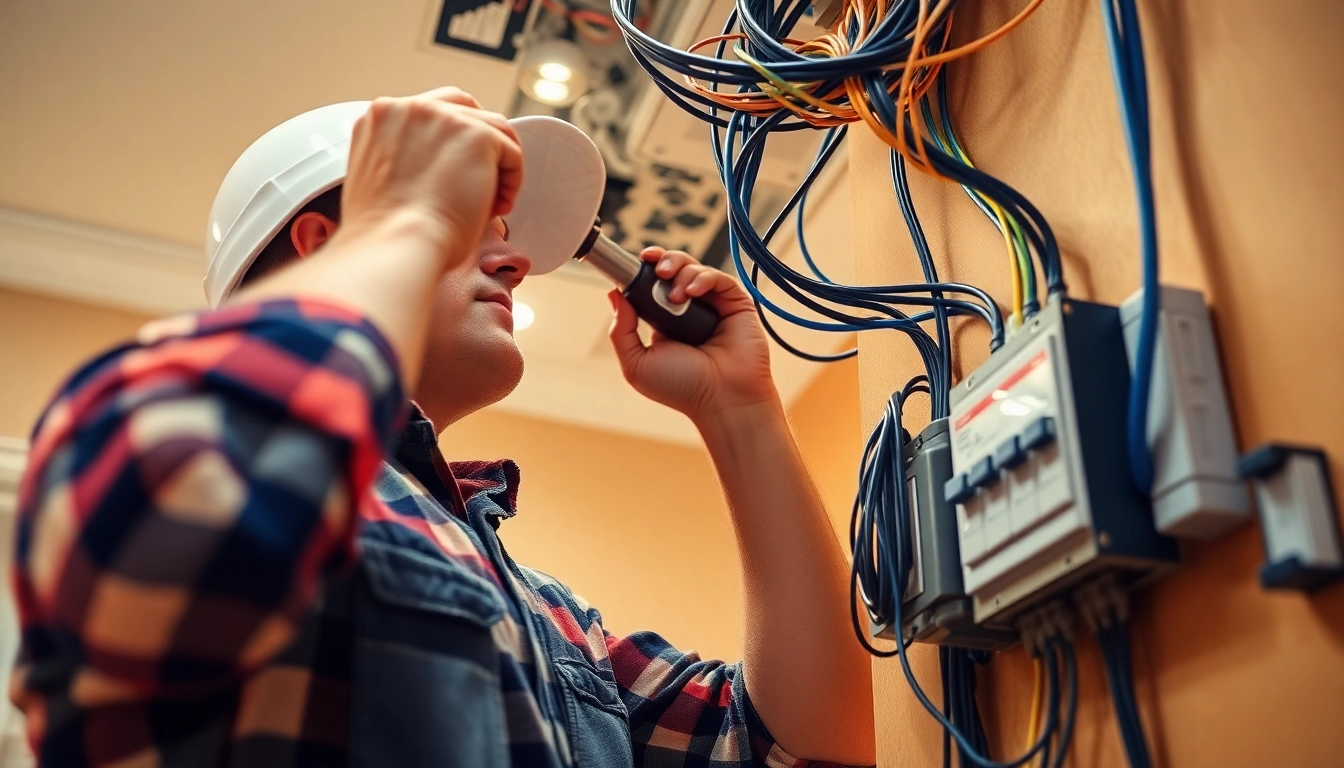
Understanding Electrical Installation Basics
In modern construction and maintenance, electrical installation plays a pivotal role in ensuring that buildings function efficiently and safely. This process focuses on the assembly, installation, and maintenance of electrical systems that provide power to a space. Understanding the fundamentals of electrical installations is crucial for both homeowners and professionals, as it ensures the safety, reliability, and efficiency of electrical systems in residential, commercial, and industrial settings.
What is Electrical Installation?
Electrical installation encompasses the entire process of installing electrical systems in a building, which includes everything from wiring and connecting various electrical devices to testing the systems for functionality. This installation is a detailed and precise task that typically involves the following key components:
- Wiring: The physical cables that distribute electricity throughout the building.
- Switches: Mechanisms that control the flow of electricity to various parts of the electrical system.
- Outlets: Points where electrical devices can connect to the electrical system.
- Lighting fixtures: Devices that provide illumination using electrical power.
- Fuses and circuit breakers: Safety devices that protect against overcurrents and prevent electrical fires.
Key Components of Electrical Systems
The effectiveness of an electrical installation is largely dependent on the quality and reliability of its components. Key elements include:
- Electric Panels: Also known as breaker panels, these are the distribution hubs for electricity throughout the building, housing circuit breakers that protect circuits from overload.
- Cabling: Different types of cables (such as NM cable for residential use or armored cable for commercial settings) are selected based on their purpose and the environment in which they will be installed.
- Grounding Systems: Essential for maintaining safety, grounding prevents electrical shock by providing a safe path for stray electricity to follow.
- Lighting Controls: These include dimmers, switches, and smart home technology that allows users to manage their lighting settings and energy consumption efficiently.
Importance of Professional Installation
Electrical installations, while occasionally manageable in small DIY projects, often require the expertise of licensed professionals. Professional electricians ensure compliance with local and national electrical codes, significantly reducing risks associated with poor installations. In essence, hiring an experienced electrician guarantees:
- Compliance with stringent safety codes, protecting both property and inhabitants.
- Proper installation techniques that adhere to best practices, enhancing system longevity.
- Minimized risks of electrical shock, fire hazards, and future repair costs.
Types of Electrical Installations
Electrical installations can be broadly categorized based on their application. Understanding these categories helps to identify the specific requirements and regulations that apply to each type.
Residential Electrical Installations
Residential electrical installation involves the wiring and electrical systems within private residences. Key considerations include:
- Power Supply: Ensuring the house has adequate electrical supply to operate all appliances.
- Circuit Layouts: Properly designing circuits to accommodate the loads of various appliances without overloading circuits.
- Future-Proofing: Anticipating future needs by including additional outlets and wiring for new technologies.
Commercial Electrical Installations
Commercial installations support the operational needs of businesses and public buildings, differing significantly from residential setups in scale and complexity. Professionals in this field must cater to:
- Higher Power Demands: Businesses often require more electrical capacity to support larger arrays of equipment and lighting.
- Energy Management Systems: Implementing systems that monitor and reduce energy consumption effectively.
- Compliance and Safety Standards: Navigating local building codes and safety standards to maintain operational legality.
Industrial Electrical Installations
Industrial settings pose unique challenges and requirements for electrical installations, including:
- Heavy Machinery: Powering and managing large machines and systems that often use specialized electrical infrastructure.
- Robust Safety Systems: Implementing advanced safety systems designed to mitigate risks inherent to industrial environments.
- Maintenance Protocols: Regular inspection and maintenance schedules to ensure systems remain operational and safe over time.
Planning Your Electrical Installation
Planning is a critical phase in any electrical installation project. A well-thought-out plan can minimize risks and ensure project efficiency.
Considerations for Safe Wiring
When planning an electrical installation, safety is paramount. Consider the following:
- Use of appropriate wire gauges based on the anticipated electrical load for each circuit.
- Adherence to local electrical codes and standards, including the National Electrical Code (NEC) in the U.S.
- Implementation of protective measures, such as fuses and circuit breakers, suitable for the system’s design.
Designing Efficient Electrical Layouts
Efficient electrical layouts not only enhance functionality but also improve safety. Consider these strategies:
- Providing ample outlets to prevent overloading and using power strips.
- Planning for the strategic placement of lighting fixtures to maximize illumination while minimizing glare.
- Ensuring accessibility of circuit breakers and panels for emergency shut-off and maintenance.
Tools and Materials Needed
A proper electrical installation requires the right tools and materials. Key tools include:
- Wire strippers and cutters for preparing and installing wiring.
- Multimeters for testing electrical properties and connections.
- Drills and screwdrivers for mounting hardware and securing installations.
- Safety gear, including gloves and goggles, to protect against electrical hazards.
Executing an Electrical Installation
Executing an electrical installation involves several steps that require careful attention to detail and adherence to safety standards.
Step-by-Step Installation Process
The installation process typically follows these steps:
- Planning: Establish a detailed plan that includes circuit layouts, loads, and electrical demands.
- Installing Wiring: Run wiring according to pre-determined layouts, ensuring all connections and terminations are secure.
- Connecting Devices: Install outlets, switches, and fixtures and connect them to the electrical system as per codes.
- Final Connections: Connect circuits to the main electric panel, ensuring the correct use of circuit breakers.
- Testing: Conduct thorough testing to ensure all systems operate correctly and safely.
Common Challenges and Solutions
Electrical installations can present challenges such as:
- Wiring Errors: Mistakes in wiring can lead to circuit failures or hazards. Solution: Double-check connections at each junction to ensure correct wiring.
- Load Overestimation: Underestimating the load can strain circuits. Solution: Calculate total load requirements and factor in future electrical demands.
- Adherence to Codes: Failing to comply with codes can lead to safety inspections and fines. Solution: Stay updated with local codes and regulations.
Testing and Ensuring Safety Standards
After installation, rigorous testing is essential to ensure compliance with safety standards. This includes:
- Continuity Testing: Checking that there is a continuous electrical path and that all connections are secure.
- Load Testing: Verifying that circuits handle the intended load without overheating or tripping breakers.
- Grounding Checks: Ensuring all grounding paths are effective to minimize shock hazards.
Cost and Maintenance of Electrical Installations
Understanding the costs associated with electrical installation is fundamental for efficient budgeting and planning.
Factors Influencing Installation Costs
Several factors can influence the overall cost of electrical installations:
- Type of Installation: Residential projects generally cost less than commercial or industrial installations due to scale and complexity.
- Material Costs: Prices for wires, outlets, switches, and fixtures can vary significantly based on quality and brand.
- Labor Costs: Hiring licensed electricians may involve higher upfront costs but ensures compliance and safety.
Budgeting for Electrical Projects
Effective budgeting involves estimating all potential costs and establishing contingencies. Consider the following guidelines:
- Obtain multiple quotes to ensure competitive pricing and understand the scope of work included.
- Set aside a contingency fund (typically 10-20% of the total cost) for unexpected expenses.
- Consider long-term savings from energy-efficient installations, which can offset initial costs over time.
Maintenance Tips for Longevity
Regular maintenance of electrical installations can extend their lifecycle significantly. Best practices include:
- Scheduling annual inspections with a licensed electrician to identify potential issues.
- Testing smoke detectors and electrical safety devices regularly to ensure functionality.
- Observing for signs of wear, such as frayed wires or flickering lights, and addressing them promptly.
In conclusion, understanding the intricacies of electrical installation is crucial for anyone working in construction, renovation, or maintenance fields. A comprehensive grasp of the planning, execution, and maintenance of electrical systems not only enhances safety but also contributes to the efficiency and sustainability of electrical infrastructures.






